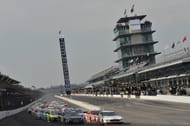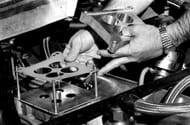On the eve of his 80th birthday, seven-time NASCAR Cup Series champion Richard Petty was asked about the upcoming changes at the Xfinity race at Indianapolis. His response was as clear as it was pointed.
In the summer of 2017, NASCAR was desperate to spice up its struggling product, especially at flat, aerodynamic-dependent tracks like Indianapolis Motor Speedway. They took a gamble of introducing restrictor plates to the Xfinity Series race at the Brickyard for the Lilly Diabetes 250.

The idea was to limit horsepower, boost aerodynamics and force cars into a more pack-style race on a track that had historically produced strung-out fields and single-file parades. But not everyone saw it as innovation, with Petty viewing it as a step too far.
"That's the wrong way to go. You don't make racing when you have something that the racers can't do anything with. You've got no power. You can catch somebody when they make a little slip, but when you get on the gas, nothing happens.," Petty told Hot Rod Magazine in 2017.
At the heart of his criticism was a belief that racing should reward the skilled, not the system-gamed. Richard Petty viewed restrictor plates as artificial tools that reduced engine power by limiting airflow and a driver's ability to race their way to the front.

At superspeedways like Daytona and Talladega, where restrictor plates had long been used to prevent dangerously high speeds and create closer packs, even Petty conceded that the results were mixed. But at the Indianapolis Motor Speedway - a flat, four-turn rectangle with long straightaways - he thought that it was absurd.
The track's reputation for processional races in stock cars is far removed from its history of tight IndyCar finishes. The plan was to re-engineer the car by combining aero ducts, a smaller 7/8-inch restrictor plate,and the 2016 splitter/spoiler package.
Wayne Auton, then the Xfinity Series director, acknowledged that the move was a calculated risk (via Autoweek).
"I don't think there's any way for certain you can say this will be a success or if it will be something we've to adjust. I think we'll take all data we can. We'll listen to drivers, and we'll listen to teams. We'll talk to Goodyear and all the parties involved."
However, for Richard Petty, it was solving the wrong problem.
"I don't know what they're trying to do, because when you look at Indy, it's a terrible place for our kind of cars to race. You can't change the cars because the track is not suitable for our kind of racing, so just changing the cars I don't think will work," he said.
In his view, the four 90-degree corners and the reliance on corner exit speed at IMS didn't lend themselves to pack racing. Worse, with plates reducing acceleration, drivers couldn't recover from mistakes or take advantage of another's slipstream and were instead stuck in line.
The one-off experiment of Lilly Diabetes 250 saw tighter restarts and 16 lead changes. But drivers like Kyle Busch complained about the package preventing the fastest car from demonstrating a clear advantage.
Where do NASCAR's restrictor plates and Indy stand eight years later?

Fast-forward to 2025, and NASCAR's approach to race packages has evolved. Restrictor plates are now part of a broader strategy shaped around the Next Gen car.
While the phrase itself is largely phased out in favor of tapered spacers and horsepower-specific packages, the concept of reducing speed at certain venues to improve safety and promote closer competition remains.
At tracks like Daytona, Talladega and now Atlanta, NASCAR continues to use the 510-horsepower package. With aerodynamic changes like a 4-inch spoiler, extended roof rails, and underbody fabric, NASCAR aims at keeping cars on the ground. But for tracks like Indianapolis, the 670-horsepower package is now the standard. The Cup Series returned to the Indy oval in 2024, after three years on the road course, and was hailed as a success.
The Next Gen car, with its improved center of gravity, symmetrical body, and better tire durability, has offered far more competitive racing than its Gen 6 predecessor. Beyond the hardware, NASCAR's rulebook also reflects that pivot.
From the new Damaged Vehicle Policy (which allows garage repairs mid-race) to playoff waiver clarifications, and even the Fastest Lap Bonus Point, the modern Cup Series is more driver-centric than it's been in years.
And that's exactly what The King was asking for all along.
Get the latest NASCAR All-Star race news, Xfinity Series updates, breaking news, rumors, and today’s top stories with the latest news on NASCAR.
